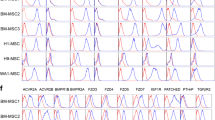Abstract
Human mesenchymal stem cells (MSCs), with capacity to differentiate into adipocytes, osteoblasts and chondrocytes, offer potential for the development of novel treatments. A critical question in MSCs biology is whether this cell population possesses a relatively uniform differentiation capability or is comprised of distinct subsets of progenitors committed to differentiate in particular pathways. To quantify the changes during growth of MSCs, we analyzed the mesenchymal phenotype and differentiation ability using a multi-marker PCR with six primer sets specific for CD73, CD90, CD105, CD166, CD45 and β-actin allowing a gel-based differential detection of the PCR products. To determine degree of variability of MSCs populations in terms of proliferation, cell proliferation assays were performed on expanded MSCs up to the sixth passage. At each passage, the osteogenic and adipogenic differentiation potentials of MSCs were verified by culture in inductive media. RT-PCR and cytochemical analysis revealed that, despite the loss of multipotentiality during expansion, certain markers remain expressed, indicating that these markers are unlikely to be reflective of the MSC’s true ‘stem cell’ nature. Our results suggest that decrease in the expression of MSCs specific markers correlates with down-regulation of proliferation ability and differentiation efficiency of MSCs.





Similar content being viewed by others
References
Banfi A, Muraglia A, Dozin B et al (2000) Proliferation kinetics and differentiation potential of ex vivo expanded human bone marrow stromal cells; implications for their use in cell therapy. Expt Hematol 28:707–715
Campagnoli C, Roberts IA, Kumar S et al (2001) Identification of mesenchymal stem/progenitor cells in human first-trimester fetal blood, liver, and bone marrow. Blood 98:2396–2402
Chamberlain G, Fox J, Ashton B et al (2007) Mesenchymal stem cells: their phenotype, differentiation capacity, immunological features and potential for homing. Stem Cells 25:2739–2749
Colter DC, Sekiya I, Prockop DJ (2001) Identification of a subpopulation of rapidly self-renewing and multipotential adult stem cells in colonies of human marrow stromal cells. Proc Natl Acad Sci 98:7841–7845
Delorme B, Ringe J, Gallay N et al (2008) Specific plasma membrane protein phenotype of culture-amplified and native human bone marrow mesenchymal stem cells. Blood 111:2631–2635
Dominici M, Blanc LK, Mueller I et al (2006) Minimal criteria for defining multipotent mesenchymal stromal cells, The International Society for Cellular Therapy position statement. Cytotherapy 8:315–317
Ivanova NB, Dimos JT, Schaniel C et al (2002) A stem cell molecular signature. Science 298:601–604
Jin HJ, Park SK, Oh W et al (2009) Down-regulation of CD105 is associated with multi-lineage differentiation in human umbilical cord blood-derived mesenchymal stem cells. Biochem Biophys Res Commun 381:676–681
Kassem M (2004) Mesenchymal stem cells: biological characteristics and potential clinical applications. Cloning Stem Cells 6:369–374
Larson BL, Ylostalo J, Prockop DJ (2008) Human multipotent stromal cells undergo sharp transition from division to development in culture. Stem Cells 26:193–201
Mareddy S, Crawford R, Brooke G et al (2007) Clonal isolation and characterization of bone marrow stromal cells from patients with osteoarthritis. Tissue Eng 13(81):9–829
Parekkadan B, Poll D, Suganuma K et al (2007) Mesenchymal stem cell-derived molecules reverse fulminant hepatic failure. PLoS One 2:e941
Phinney DG (2007) Biochemical heterogeneity of mesenchymal stem cell populations: clues to their therapeutic efficacy. Cell Cycle 6:2884–2889
Pittenger MF, MacKay AM, Beck SC et al (1999) Multilineage potential of adult human mesenchymal stem cells. Science 284:143–147
Ramalho-Santos M, Yoon S, Matsuzaki Y et al (2002) “Stemness”: transcriptional profiling of embryonic and adult stem cells. Science 298:597–600
Sekiya I, Larson BL, Smith JR et al (2002) Expansion of human adult stem cells from bone marrow stroma: conditions that maximize the yields of early progenitors and evaluate their quality. Stem Cells 20:530–541
Smith JR, Pochampally R, Perry A et al (2004) Isolation of a highly clonogenic and multipotential subfraction of adult stem cells from bone marrow stroma. Stem Cells 22:823–883
Sogo S, Inaba M, Ogata H et al (1997) Induction of c-kit Molecules on human CD34+/c-kit<low cells: Evidence for CD34+/c-kit<low cells as primitive hematopoietic stem cells. Stem Cells 15:420–429
Sordi V, Malosio ML, Marchesi F et al (2005) Bone marrow mesenchymal stem cells express a restricted set of functionally active chemokine receptors capable of promoting migration to pancreatic islets. Blood 106:419–427
Sotiropoulou PA, Perez SA, Salagianni M et al (2006) Characterization of the optimal culture conditions for clinical scale production of human mesenchymal stem cells. Stem Cells 24:462–471
Tremain N, Korkko J, Ibberson DG et al (2001) MicroSAGE analysis of 2,353 expressed genes in a single cell-derived colony of undifferentiated human mesenchymal stem cells reveals mRNAs of multiple cell lineages. Stem Cells 19:408–418
Tyndall A, Walker UA, Cope A et al (2007) Immunomodulatory properties of mesenchymal stem cells: a review based on an interdisciplinary meeting held at the Kennedy institute of rheumatology division, London, UK. 31 October 2005. Arthritis Res Ther 9: 301
Wagner W, Horn P, Castoldi M et al (2008) Replicative senescence of mesenchymal stem cells: a continuous and organized process. PLoS ONE 3:e2213
Yang GP, Ross DT, Kuang WW et al (1999) Combining SSH and cDNA microarrays for rapid identification of differentially expressed genes. Nucl Acids Res 27:1517–1523
Acknowledgement
We wish to thank Dr. Kavitha for correcting the manuscript and Dr. Santhosh Mathapati for his help on statistical analysis. Our thanks are due to our team members Mr. Satish Galla, Ms. Bala Sundari, Ms. Sheerin Begam Naser and Mr. A. Pandian for their kind help rendered.
Author information
Authors and Affiliations
Corresponding author
Additional information
Suneel Rallapalli and Dillip Kumar Bishi have contributed equally to this work.
Rights and permissions
About this article
Cite this article
Rallapalli, S., Bishi, D.K., Verma, R.S. et al. A multiplex PCR technique to characterize human bone marrow derived mesenchymal stem cells. Biotechnol Lett 31, 1843–1850 (2009). https://doi.org/10.1007/s10529-009-0106-2
Received:
Revised:
Accepted:
Published:
Issue Date:
DOI: https://doi.org/10.1007/s10529-009-0106-2




